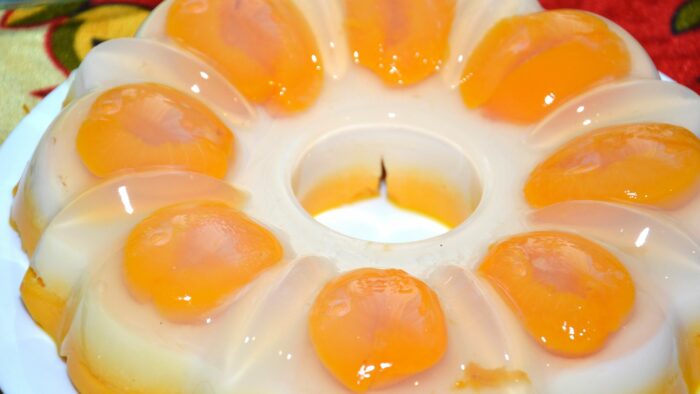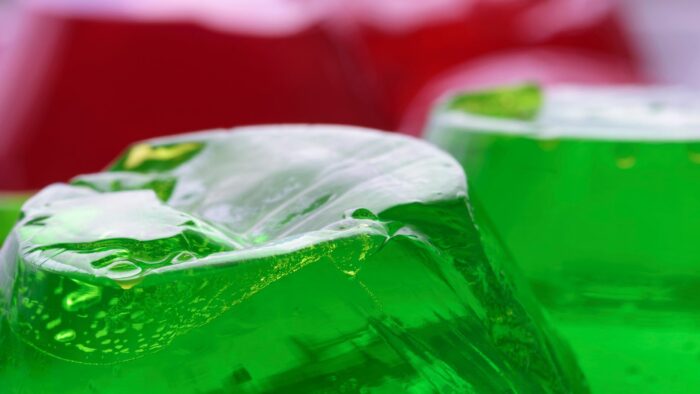Last Updated on February 18, 2023
Wondering how to keep jello from sticking? Check this article and find out.
It wiggles, it jiggles, and we were probably all crazy about it when we were kids. However, there are also those who still don’t hide their love for this super tasty delicacy. It’s about America’s Most Famous Dessert for more than 100 years, jelly.
This cold, sweet, and refreshing all-time hit can be prepared in a variety of molds, giving you the freedom to create whatever shapes and sculptures you can think of. However, most of us struggle with the same thing, therefore, stay with us and learn how to keep jello from sticking.
What Is Jello?
Did you know that this gelatin-based dessert has been on American menus since 1897? Much longer than you expected, right? Although the largest percentage of us identify this sweet substance with school snacks and hospital trays, keep in mind that its popularity is much more widespread and is used among dieters as a low-calorie treat.

As for its composition, the primary ingredient is gelatin. Right off the bat, we want to clear up a few things that are often discussed, so let’s get straight to the point.
Gelatin is made from animal collagen, specifically the protein that makes up connective tissues such as skin and ligaments. All those who keep trying to convince us that gelatin is obtained from horse or cow hooves are wrong. Hooves are mainly made of keratin, which although it is a protein, can’t be made into gelatin. All discussions on this topic should end there.
As for the production process itself, it is very simple, but for some of you it can be quite disgusting, but it doesn’t hurt to know the origin of the food that we put into our own bodies. In short, the best source of animal collagen is pigs and cows, specifically not whole animals, but their skin and bones. The manufacturers boil, dry, and treat the skins and bones of certain animals with a strong acid or base and at the end of the process, perform filtration until all the collagen is extracted. When it is ready, the collagen is then dried, ground into a powder, and sieved to obtain the final product, i.e. gelatin.
Now that I have introduced you more closely to the ingredient we will talk about today, let’s try to find out how to keep jello from sticking. If you are in favor, let’s hurry up with the details!
How to keep jello from sticking?
When all is said and done, unlike many ingredients that can be found in our pantries, gelatin is the most temperamental one and demands quite specific care. However, this shouldn’t distract you from your intention or limit you to only consuming those purchased. Once you figure out what the trick is, things will get a lot easier. In any case, don’t give up; we will explain how to keep jello from sticking, in the next few paragraphs.

Can You Make Jello In Silicone Molds?
To make the perfect jello you need the right mold, right? If you choose the ideal one, you shouldn’t have any problems getting it out.
The two most common materials from which Jello molds are made are plastic and silicone. Which one you choose depends on your preferences. Each of them has its advantages and disadvantages, but it will serve its purpose. What I have learned from my many years of ups and downs is that glass and ceramic molds are heavy and clunky, so I would recommend sticking to silicone or plastic ones. But I don’t want to stop you from trying other materials; you may be much more successful and skilled than I am.
How To Get Jello Out Of A Silicone Mold?
Generally speaking, it is easiest to remove any food, including jello, from a silicone mold than from any other mold material. Although you can make jello in any shape, if it sticks, it can tear, and when it does, it’s done and there’s no way to fix it.
So, how to keep jello from sticking to molds? The most important thing is to have enough patience and let it cool and harden. In addition, you can always use water-soluble adhesive.
How to unmold jello: Step-by-step guide
#1: First, give your jello enough time to set, then perform the test with your fingertip to determine if it’s time to remove it from the mold. If it feels quite sticky, give it more time, and if not, then you know what to do.
You can also tilt the silicone mold towards you and away from you. Look carefully, a perfect jello should not sag in any one direction. In case it sags, you will have to set it for a few more hours.
#2: Moisten your fingers to reduce friction between your skin and the jelly membrane, and then gently and patiently run your fingers under and around the edges of the silicone mold, trying to pull the jello away from the sides of the mold.
#3: After you have finished, fill a large basin with warm water (it mustn’t be hot so that your hard-earned dessert doesn’t melt) and immerse the mold in it. Be careful, the water must not touch the sides of the mold, but it mustn’t pour inside.
#4: Finally, take it out of the water, and shake it to loosen the jello. Cover with a plate and turn over. If you feel resistance, feel free to return it to the water and repeat the process until you succeed. Although, if you follow these steps carefully, there should be no problem.
That’s it, now you know how to keep jello from sticking!
The Bottom Line
You don’t need to be an expert to know that the purchased jellos have very low, to non-existent nutritional value and that they are also rich in artificial colors, sweeteners, or sugar — which undoubtedly may have many negative health effects. Therefore, the option to make it yourself is always the best.
In addition, we believe that you have now learned how to keep jello from sticking. What’s stopping you from trying to make at least one today?
Recommended:
How To Toast English Muffins Without A Toaster? 4 Easy Ways


